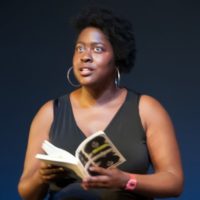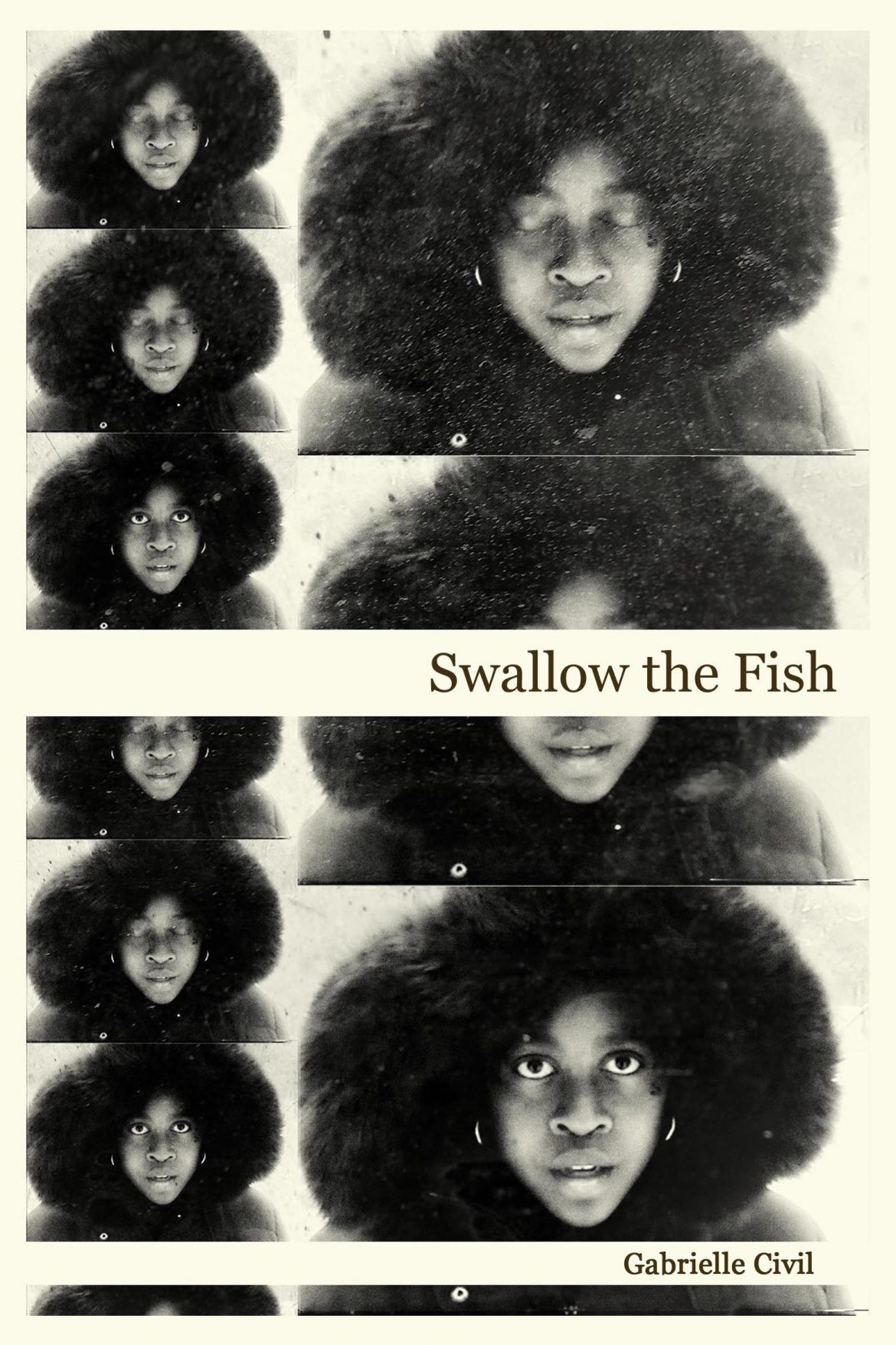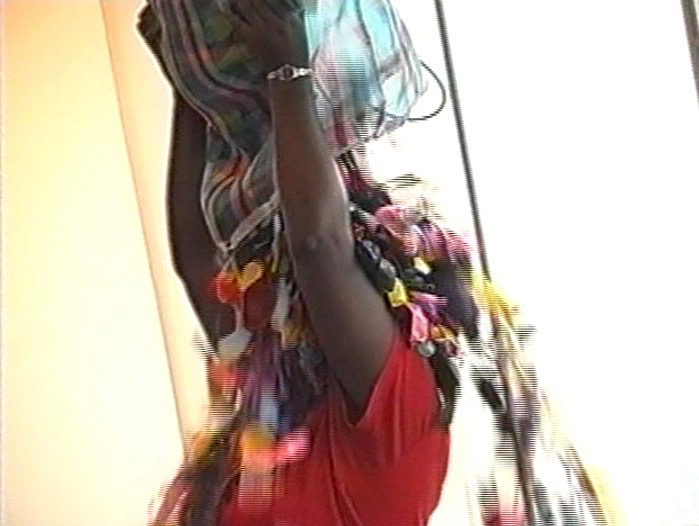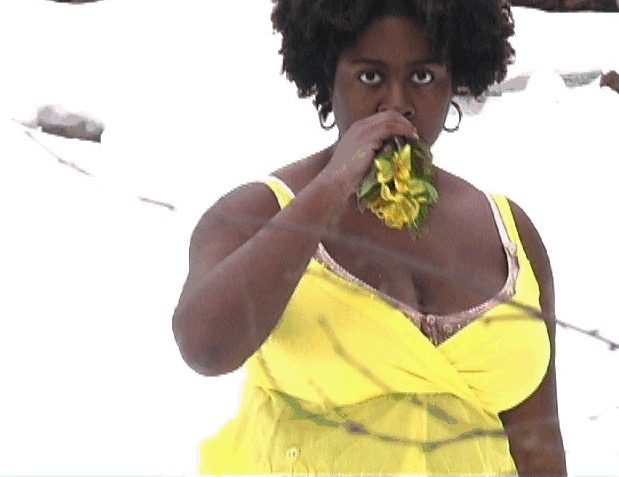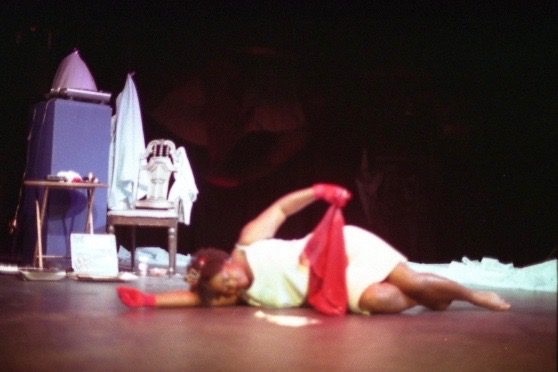Gabrielle Civil’s book, Swallow the Fish, is an account of artist collectives and art history, from the perspective of a woman of color. It’s an exploration of the interiority/exteriority of life as a performance artist and poet, a brave and at times humorous memoir.
What I love about the book is its engagement with presence and embodiment that adds dimension to her wonderful poetry. I love the risk of putting on display vulnerability, the artist at the center of what is erotic, beautiful—that our bodies through works of art can change people.
Civil writes about coming of age as an artist in 90s New York City, a time where you could walk out into the city streets and you never knew where you would end up; when George W. Bush was the establishment head to take down; when protesting the Iraq War was in the news. (Remember the Iraq War?) When David Blaine, the man who tried to live submerged in water for thirty days, was on the billboards.
I interviewed Gabrielle in January.
***
The Rumpus: Swallow the Fish includes poetry, essays, artist notes, performance texts, reviews, conversations with friends—the book is a compendium of a fully lived artist’s life. The performance pieces, preparation and aftermath, form a vertebrae that keeps the emotional growth of you as an artist and your engagement with self and body moving forward. Could you talk a bit more about why you structured the book chronologically?
Gabrielle Civil: Yes! I love the idea of the performances as vertebrae, since so much of the book is about gaining the backbone to make performance art, to see myself as a performance artist, to be seen and move in the world that way. Although I do move a couple things around for thematic unity, the chronological order gives the book its shape as a memoir. It’s not a traditional autobiography but a story of my coming of age in art. A friend read it and said you know I’d love to read a book that actually tells about your life—exactly where you were when and what you were doing and how you got there. And I laughed because STF is certainly not that.
More than anything, Swallow the Fish offers the interiority of my performances. The book aims to make the invisible parts of performance visible—the thinking, the feeling, what Toni Morrison calls “the figuring out and the figuring in.” It also highlights how much writing is a part of performance for me. Even if I’m not speaking in a performance, or if it seems like there’s no text, for me there’s always text—the text is my body—and there’s always writing. I write into the body, into my body, into my dreams of what my body can do. Swallow the Fish is a documentation and invitation into that writing. The book is a paper trail of my ephemeral art/life.
Rumpus: One aspect that fascinated me was your take on documentation. How do you think documentation has stood in for performance? I’m referring to your performance of “Berlitz” where you privileged the performance over the documentation.
Civil: Because performance is an ephemeral form, documentation can often take the place of the artwork itself. A photograph, a video, a text, a review, or even artist notes like Costume en Face, Sawako Nakayasu’s incredible translation of Butoh master Tatsumi Hijikata’s dance notations, become what is left, attempts to capture lightning in a bottle. This is a great gift, because otherwise the performance would disappear. In fact, Swallow the Fish was motivated by the disappearance of so many black women artists from the public record, incredible people like Anne Spencer or Maudelle Bass whose work has been lost to time. But we also have to be careful because documentation is not the same thing as the live artwork itself. With “Berlitz,” a conflict arose where the work itself would have been radically changed just for the purpose of video documentation. To me, that felt like putting the cart before the horse. Video can be tricky anyway because it doesn’t show what actually happened, it only shows what it looked like. These are not the same thing. This is where my identity as both a poet/writer and performance artist is interesting because the two modes work so differently. In performance, the goal is to be completely present in the moment. In writing, you’re striving to stand the test of time.
Rumpus: It strikes me that you’ve been a performance artist and lived within art spaces for several decades but only committed to the written page after many moments of engaging and embodying your art. You mention that dissemination is never disembodied, how objects are traces of the body, “it can matter tremendously whose body is leaving the trace and how that body moves in the world.” This feels the opposite of many creative writing MFA programs where the end goal is to publish a book as soon as possible and less about how you live as an artist.
Civil: Before Swallow the Fish, I published poems, essays, translations, and performance texts in journals and did a collaborative book called Tourist Art with the wonderful Haitian-American artist Vladimir Cybil Charlier. Still, Swallow the Fish is my first big book baby. It is the first account of my work and life as an artist. I always say: it took a long time to write, a longer time to get published, and an even longer time to live. And as long as it is, it’s not even exhaustive. Right now, I have three other performance-related books, one of which deals with international performances that took place in the same era as Swallow the Fish. I also have completed a poetry collection and a full-length poetry translation. So much juicy stuff!
For many years, not having a book was deeply painful, because I too had been trained to have a book as soon as possible. A book seemed like the key to the door into another life, the real life of the poet, writer, artist. But especially as a poet, getting a first book seemed like hitting the lottery. At this point, I have many friends who have done it. Back then, the Internet wasn’t big, so there weren’t many online journals, and everything was snail mail and stamps and no simultaneous submissions and waiting a long time. I was so impatient.
One thing that helped was being Gwendolyn Brooks’s personal assistant at the Slave Routes conference in New York. One day, she said to me, “Gabrielle, don’t rush it. Your first book is something that can only happen once. Take your time.” So that took out some of the sting because—hey! I was riding in a cab with Gwendolyn Brooks, one of the most brilliant US poets and writers ever, and a generous, wonderful person. I felt so lucky just to be there. And even then, I knew that a career is not the same thing as a life. Still, publishing was hard. I was always writing, but felt at the mercy of editors. So, on some level, my first turns to performance were also a way to not let my frustration with publishing stop me from creative writing in the world.
Rumpus: I was in a poetry workshop recently and the instructor asked us to introduce and respond to the critiques of the poems, be more authorial in our voice. I remember this threw off many poets who were expecting everyone else to examine and give feedback to their work. Later I reflected on how unfair and ultimately pointless a one-sided poetry workshop might be from the point of view of a person of color. Would you be able to expand some more about how you want the thoughts, processes, procedures behind artmaking to be more explicit?
Civil: A one-sided poetry workshop is problematic for everyone, because it can too easily reinforce unquestioned, unwarranted assumptions about art and life. Aesthetic values are social and political tastes coming from particular social and political contexts. Without very clear facilitation, people of color, queer people, working class people, anybody who doesn’t participate in what Audre Lorde called “the mythical norm” can be subtly—or not so subtly—asked to conform their work to outside standards. This is inappropriate, and worse, incredibly boring.
Clearly, it can be helpful to listen to reader responses. It can also be excruciating, demoralizing and destructive when those comments are thoughtless or ill-informed. It can also nip something in the bud. Aisha Sabatini Sloan just wrote something brilliant about this, racial dynamics in the MFA workshop and “the lure of writing for a white audience.” Even white people shouldn’t be only writing for a white audience. But too often, people assume that’s the only audience that matters or even exists. (To quote Shonda Rhimes, “Girl, please.”) To avoid this disaster, we all need to be very clear about the kind of work we’re trying to make, the questions we want to ask, the audiences we want to reach, and the models of art making and writing that matter to us. We also need to recognize that this can be different for different people, even within the same social group. We also need to register a wide variety of career ambitions and possibilities.
Before jumping into recommendations, I think we should share artistic visions and especially inspirations. Who do you read? What art and music matters to you? Which literary and aesthetic traditions have mattered to you and why? What are your aspirations for your work? What are your fears? Those conversations would lead to a richer creative environment and more productive feedback.
Rumpus: Have you noticed any difference with the way young female artists produce and discuss their own artwork that was different from the time when you first started making art?
Civil: Well, the Internet has radically changed the way that all young and emerging artists produce and discuss everything. I still feel young and sexy, but I look at some of my undergraduate students and think—I’m old enough to be your mama, and not your teenage mama either! So, I know how the whole sense of being in the world has changed.
Madhu H. Kaza and Rosamond S. King and I were just talking about that recently because in the 90s we had an experimental, conceptual art collective called No. 1 Gold that produced these magical projects in New York City that no one knew about. At the last Thinking Its Presence conference, we did a performance/ lecture/ presentation about the twentieth anniversary of the Gold Leaf Project where we wrapped more than 10,000 poems in gold foil and distributed them one day by hand in all five boroughs of the city. Again, no one knew that we did this. Maybe a handful of pictures exist from that day, taken with disposable cameras that we bought at the drug store.
That was our aesthetic. Dream an idea and do it. Be actually in the world, not virtually, because there was no virtual reality. Just the possibility of magic. And it was our job to find and make magic. Slipping secret messages into library books. Writing letters to become an artist and sending postcards. We built our own aesthetic sensibility and community with nobody watching. We could dream and try things out without scrutiny or immediate likes or condemnation. I see now how much of a gift that was.
Rumpus: Do you feel nakedness and the female body was a specific movement that was more prevalent in the 90s? I’m also thinking of your analysis of Saartjie Baartman (“Hottentot Venus”) and how the white gaze has always been fascinated by the female nude and the horripilation of the bodies of women of color.
Civil: Remember that band Barenaked Ladies? That was a lot of 1990s (and 1980s and 1970s) performance art. Internationally, the nude body does still seem to have a strong hold on the form. The United States is more puritanical, and the left is more interested in de-essentializing a specific body or body parts from gender identification. (For example, at the school where I’m teaching this year, The Vagina Monologues has been replaced by The Genital Monologues.) This has led to important feminist conversations, deeply informed by queer theory and culture, but also some ambivalence about the place of the body in identity and art.
The Internet, smartphones, and social media have also had a big impact on nudity in the US because all events in every realm of life are now automatically photographed and often posted online. Because the Internet is so omnipresent, and impossible to erase, it can become a different proposition to take off one’s clothes.
Still, nudity can be powerful, sometimes ironically in its banality. It can be matter of fact, not a big deal, just exposing the humanity of a person. On the other hand, it can be a super big deal, the real deal of reckoning with an actual, non-photoshopped naked body in the flesh. Real bodies remind us that beauty and attraction encompass far more than what we see on TV.
That’s one of the most interesting lessons of Saartjie Baartman: the level of undeniable attraction and deep erotic desire Europeans had for someone they claimed to be so monstrous. They loved her and reviled her. They loved reviling her. The key for women of color today is to not internalize that projected monstrosity or exploitation or shame. This is very, very difficult.
Rumpus: Can you talk about cities that welcome you? I loved the incident of performing “Berlitz” with two different audience reactions. The first audience mostly white and discouraging; then the sea change experience of performing in front of a more diverse, welcoming audience.
Civil: On the Swallow the Fish world tour (holla!), many places welcomed me—Toronto, Reykjavik, and my art hometown Minneapolis. Despite what happened with “Berlitz,” the Twin Cities has shown me a lot of love over the years. What’s been great is how places like Iowa City, Duluth, MN, or College Station, TX have also responded warmly to me. I love bringing my work to college classrooms, conferences, or small art centers, and talking to people who maybe have never seen anyone, and certainly not someone dark and plump, doing live art in the world. At Texas A&M, one young white man stood in line afterwards just to shake my hand. It made me feel a little better about America.
With that said, Mexico City was profoundly welcoming to me and is one of the most amazing, wonderful cities in the world. This year, I’m hoping to finally get out my “In & Out of Place” catalogue documenting the year and a half of performance works that I made there. Race, gender, nationality, bodies, all operated very differently for me and so the experience snapped me out of a lot of habits. Living and making art in Mexico was one of the most transformative experiences in my life. I also have to shout out Detroit, a city where I have never performed, but where I was born and raised. It remains my deepest and most important home place.
Rumpus: You write about how many art critics, audience members or friends described the experience of being changed after your performance. What does being changed mean for you in terms of performance art?
Civil: Being changed means taking the risk of being there, being open to whatever is happening with the performer and with oneself. It’s mysterious and can take a long time. Emails and Facebook ask for immediate response. With performance art and poetry, with art and writing in general, it can be slow. You might not recognize the change until a long time after. Being changed can also mean being surprised, not seeing precisely what you thought you’d see or wanted to see. We need affirmation, especially those of us who have long been marginalized, silenced, and erased. We also need delight and wonder and questioning. This goes back to the process of giving/ receiving feedback. Too often people want to jump to what’s wrong or what should be different or changed or even to what they already know they like. Does something get under your skin? Have you ever hated something and then loved it? Are you still thinking about it? It can take time to understand even what something is trying to say or do or be. Or what effect it is having. To be changed is to risk changing. It is to embrace the magic of the world.
***
Feature photograph by Dennie Eagleson. Photograph of Gabrielle Civil in “after Hieroglyphics” by Sayge Carroll. Video Still of Gabrielle Civil in Yawo’s Dream by Ellen Marie Hinchcliffe. All photographs provided courtesy of Gabrielle Civil.
